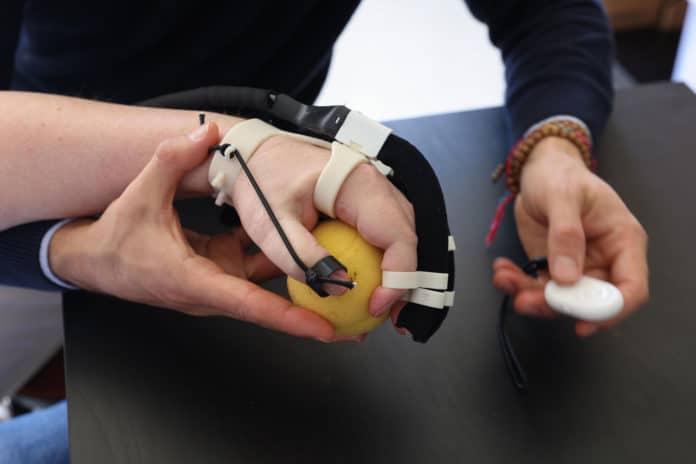Stroke is a major cause of long-term disability. Nearly 12 million people worldwide survive a stroke every year, and half of them are left with at least some limits on the use of their hands. Various portable robotic systems and human-machine interfaces have been developed to address this challenge in recent years, but they are often too complex or expensive.
To overcome these obstacles, EPFL spin-off Emovo Care has now developed a device called Emovo Grasp. Emovo Grasp is light and easy-to-attach hand exoskeleton for people unable to grasp objects following a stroke or accident. Engineers developed the device with the help of disabled users over the course of several years and then improved it further through several rounds of testing in hospitals and rehabilitation centers.
Emovo Grasp consists of two patented artificial tendons. These tendons resemble thin cables inserted into a sheath. Engineers attached these tendons along the back of the hand using silicon rings placed on each finger. The motor and the remote control, which allows the user to modify the force exerted, are kept separate in tiny cases. To optimize sensory input, this design frees up the palm and the tips of the fingers.
Upon activation, the device applies light pressure on the index and then the middle finger so that they each pivot and come into contact with an object. Even on oddly shaped items, the hand changes its grip automatically to enable the most natural movement possible. Another button on the remote control sends the opposite command, causing the cables to pull and straighten the fingers, allowing the object to be released. The bio-inspired artificial tendons are analogous to the natural system of muscles and tendons in hand.
CEO Luca Randazzo, who developed this technology during his thesis and postdoc at the EPFL Brain-Machine Interface and Biorobotics Laboratories, said, “Our design produces gentle movements and a strong grasp. The device itself never acts on its own – the user is always in control so they can avoid dropping things or gripping at the wrong time.”
Anne-Lise Joray-Tendon, a physiotherapist at the Centre Rencontres, sees great therapeutic value in the device: “Patients could train for an extra 15 minutes each day following their standard treatment, or take the device home to continue their rehabilitation. This device is very promising because repetition is key to progress.”
Emovo Care co-founder and COO Iselin Frøybu adds: “The next day, after seven years of complete immobility, I could move my index finger two millimeters without help – that was amazing. We are still collecting data to develop reliable statistics, but patients report that after the first few uses, they feel that their hand is part of their body again, whereas they used just to neglect it.”
